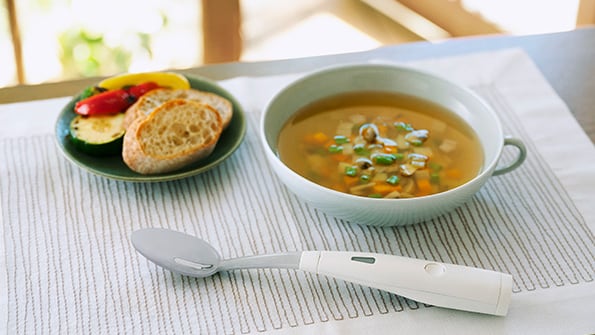Launched under the firm’s Health Science domain, the Electric Salt Spoon uses a “unique current waveform” that enhances the perceived salty flavour when eating low-sodium foods.
The technology was developed through joint research with Dr Homei Miyashita from the Department of Frontier Media Science in Meiji University’s School of Interdisciplinary Mathematical Sciences.
According to data from the National Health and Nutrition Survey 2019 published by Japan’s Ministry of Health, Labour and Welfare (MHLW), the daily salt intake of Japanese adults is 10.9g for men and 9.3g for women, which is significantly higher than WHO’s recommended intake of 5g.
“Excessive salt intake can lead to the onset and increased severity of lifestyle-related diseases such as hypertension and chronic kidney disease, and has become a major public health issue.
“In order to achieve the target amounts (less than 8g and less than 7g per day for adult men and women respectively) set by the MHLW, it is necessary to reduce current salt intake in the Japanese diet by more than 20%. However, many people find low-sodium diets to be bland, and this has been a hurdle to maintaining such diets,” Sumiko Oi from Kirin’s Corporate Communications Department told FoodNavigator-Asia.
In an online survey conducted by the firm, approximately 47% of all respondents, comprising 4,411 men and women aged between 40 and 79 who were living in Tokyo, were eating a low-sodium diet or intended to do so.
Notably, about 60% of respondents “had issues with” low-sodium foods. Among these, approximately 80% were dissatisfied with the taste.
This suggests that better-tasting low-sodium diets could play an important role in improving the country’s nutritional issues.
“People trying to reduce salt intake often say that they understand the importance of it, but it is too hard to persevere. This prompted us to start research and development in 2019, which finally led to the commercialisation of the Electric Salt Spoon after more than five years.
“Through this device, we hope people who have difficulty starting or continuing salt reduction will use it as a tool to enjoy a wide range of meals and enrich their dietary lifestyle,” said Ai Sato from Kirin’s Health Science Business Department.
Initial sales limited to 200 units of the spoon were made available on its official online store in May. From June, a select number of units will be sold at Japanese department store chain Hands.
How it works
Another survey conducted by Kirin included 120 men and women aged between 30 and 69 who were trying to reduce salt consumption.
The participants ranked ramen and miso soup in first and second place respectively as the “food they would like to eat with a strong flavour”.
Kirin recognised this as a desire to eat ramen with a strong taste as a “reward” for refraining from eating it, as well as people’s need to enjoy foods that are eaten on a daily basis, such as soup, in a delicious way.
The battery-operated spoon comes with four levels of intensity (0.1 to 0.5 mA). When switched on, the current is passed from the tip of the spoon to the food to enhance its taste.
Designed with a focus on ease of use and durability, the lightweight spoon can be used as one would a regular spoon. It can be used with soups, curry, fried rice, ramen noodles, among others.
“We have confirmed in a clinical test involving people who adopt a low-sodium diet or have reduced salt intake in the past. It was shown that the saltiness perceived when eating low-sodium food is enhanced by about 1.5 times.
“Nevertheless, it should be noted that individuals may have varying experiences and the perception may differ depending on the dish,” Sumiko said.
She added that Kirin, along with Meiji University, has previously developed prototypes of other tableware, such as chopsticks and bowls.
“We decided to first bring to market the spoon in consideration of the technical characteristics and the meals for which there are high consumer needs.
“Kirin will continue to develop other tableware and low-sodium food products, while working with companies and local governments to expand the use of the Electric Salt Spoon and its market.”





